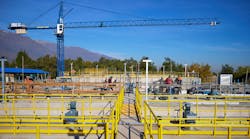As local governments continue to deal with the consequences of state and federal funding cuts, their attention naturally focuses on large-ticket items impacting their operating budgets.
There is hardly a larger ticket item than the cost of energy used for the operation of water and wastewater systems—accounting for 25% to 40% of the operating budgets for wastewater utilities and approximately 80% of drinking water processing and distribution cost, according to the U.S. Environmental Protection Agency.
The good news is that energy costs can be reduced by improving system operations and upgrading equipment, and through promoting water conservation and water loss prevention measures. Just increasing the efficiency of pumps and aeration equipment can achieve significant cost savings.
For example, Manteca, a city in San Joaquin County, Calif., is planning to upgrade its existing blowers with high-efficiency turbine blowers at its wastewater plant in an effort to extend its string of five straight years without an increase in sewer rates. The savings potential was identified during an audit under the California Wastewater Optimization Program, according to a recent Manteca Bulletin report.
Utilities also are considering the use of various alternative energy options to reduce dependence on traditional energy sources. Wind turbines and solar panels are quickly emerging on facility sites to power water and wastewater treatment operations.
Some wastewater facilities are taking advantage of onsite energy generation by capturing the energy in wastewater and utilizing biogas from their anaerobic digesters in a combined heat and power system as “free” fuel to supplement some or all of their energy use, turning them into “net zero” consumers of energy.
Of course, improving system operations and upgrading facilities with new energy-efficient technologies does not come for free. Despite the financial barriers, perhaps the most compelling argument in favor of investing in energy efficiency improvements is that they provide utilities with an opportunity to free up much-needed resources that otherwise would be spent on energy costs. Additionally, utilities are already under a lot of pressure to keep service rates down, and managing their energy use can alleviate some of this pressure.
As water infrastructure and outdated equipment creep closer to their expiration dates, it is critical for water and wastewater facilities to turn to energy-efficient improvements and become responsible energy consumers and producers. The technology choices we make today can determine not only energy use, but the sustainable future of our water and wastewater facilities for decades to come. It is time to recognize that efficient energy use leads to smart use of our resources, including the most precious one of all—water.
Download: Here


